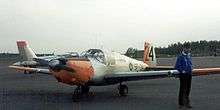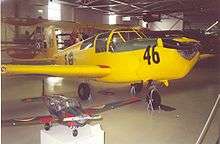Saab 91 Safir
| Saab 91 Safir | |
|---|---|
 | |
| Saab 91C of the Swedish Air Force | |
| Role | Trainer |
| National origin | Sweden |
| Manufacturer | Saab |
| Designer | A J Andersson |
| First flight | 20 November 1945 |
| Primary user | Swedish Air Force |
| Produced | 1946-1966 |
| Number built | 323 |
|
| |
The Saab 91 Safir (Swedish: "sapphire") is a three (91A, B, B-2) or four (91C, D) seater, single engine trainer aircraft. The Safir was built by Saab AB in Linköping, Sweden, (203 aircraft) and by De Schelde in Dordrecht, Netherlands (120 aircraft).
Design and development
The Safir's first flight on 20 November 1945.[1] The all-metal Safir was designed by Anders J. Andersson, who had previously worked for Bücker, where he designed the all-wood Bücker Bü 181 "Bestmann". The Safir thus shared many conceptual features of its design with the Bestmann.
The Saab 91A is powered by a 125 hp four cylinder de Havilland Gipsy Major 2c piston engine, or a 145 hp Gipsy Major 10 piston engine. The 91B, B-2 and C have a six-cylinder Lycoming O-435A engine with 190 hp.[2] The 91D has a four-cylinder Lycoming O-360-A1A engine with 180 hp.
The "Safir" was later used as a platform to test at low speeds the new swept wing for the Saab 29 and Saab 32 jet fighters.
Operational history

323 units were built in 5 versions (A, B, B-2, C and D). The Safir was used by the Swedish, Norwegian, Finnish, Austrian, Tunisian and Ethiopean air forces as a trainer aircraft, and a single aircraft was used by the Japan Defense Agency as an STOL test platform.[3]
Major civilian users were Air France, Lufthansa and the Dutch Rijksluchtvaartschool (RLS) on the Groningen Airport Eelde, near Groningen.
During development of the Saab 29, the initial Saab 91 prototype was modified with a scaled-down version of the Saab 29's swept wings; this aircraft was designated Saab 201 Experimental Aircraft. This same airframe was later fitted with wings designed for the Saab 32 Lansen; this was designated Saab 202.
A single Saab 91 Safir was modified as the Saab X1G for research in Japan.
Variants

- 91A - Original production version, powered by 145 hp (108 kW) de Havilland Gipsy Major 10 engine. Three seats.[1]
- 91B - Three seat version with 190 hp (140 kW) Lycoming O-435.[1]
- 91B-2 - 91B variant for Royal Norwegian Air Force with minor modifications, mainly a constant speed propeller.
- 91C - Four seat version of 91B, with fuel tanks moved to the wings, and a constant speed propeller.[4]
- 91D - Four-seat version, powered by 180 hp (130 kW) Lycoming O-360 engine driving a constant speed propeller.[5]
Operators
Military operators
- Finnish Air Force Former operator
- Finnish Frontier Guard Former operator
- Technical Research and Development Institute
Civil Operators
- Paraguayan Aeroclub
Specifications (91A)

Data from Safir in the Air[6]
General characteristics
- Crew: 1
- Capacity: 2 passengers
- Length: 7.80 m (25 ft 7 in)
- Wingspan: 10.60 m (34 ft 9 in)
- Height: 2.20 m (7 ft 3 in)
- Wing area: 13.6 m² (146 sq ft)
- Max. takeoff weight: 1,000 kg (2,200 lb)
- Powerplant: 1 × de Havilland Gipsy Major X four-cylinder air-cooled inline engine, 145 hp (108 kW)
Performance
- Maximum speed: 264 km/h (143 knots, 164 mph)
- Cruise speed: 235 km/h (127 knots, 146 mph) (econ cruise)
- Stall speed: 85 km/h (46 knots, 53 mph)
- Range: 942 km (509 nmi, 585 mi)
- Service ceiling: 4,600 m (15,100 ft)
- Rate of climb: 5.3 m/s (1,050 ft/min)
See also
- Aircraft of comparable role, configuration and era
References
- "Saab 91 C Safir". Flight, 1 January 1954, pp. 2–3, 21.
- Smith, Maurice A. "Safir in the Air". Flight, 23 October 1947, pp. 459–462.
- Taylor, John W. R. Jane's All The World's Aircraft 1961–62. London: Sampson Low, Marston & Company, 1961.
- Taylor, John W. R. Jane's All The World's Aircraft 1966–67. London: Sampson Low, Marston & Company, 1966.
External links
| Wikimedia Commons has media related to Saab 91. |
- Ärna Flygclubb Swedish language
- FC Flygkubb
- SAAB 91 D Safir - HB-DBL
- SAAB 91 Safir for MS Flight Simulator